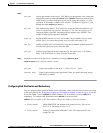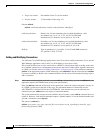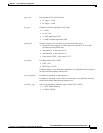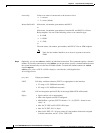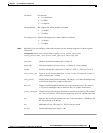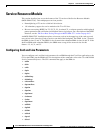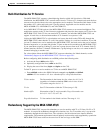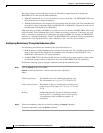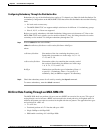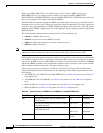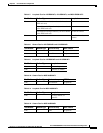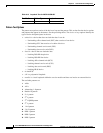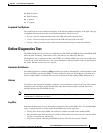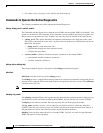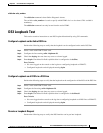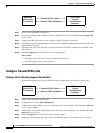
6-63
Cisco MGX 8850 Multiservice Switch Installation and Configuration
Release 1.1.31, Part Number 78-11223-03 Rev. B0, May 2005
Chapter 6 Card and Service Configuration
Service Resource Module
Configuring Redundancy Through the Distribution Bus
Redundancy by way of the distribution bus applies to T1 channels you linked for bulk distribution. For
a redundancy configuration on the MGX-SRM-3T3/C that utilizes the distribution bus note the following
items.
• No back cards are necessary.
• The MGX-SRM-3T3/C can support multiple switchovers for different 1: N redundancy groups.
• Slots 9, 10, 15, or 26 are not supported.
Before you specify redundancy with bulk distribution, linkage must exist between a T3 line on the
MGX-SRM-3T3/C and a primary service module with the T1 lines. No linkage should exist on the
secondary service module. To configure redundancy through the CLI:
Step 1 Execute addred on the active PXM1:
addred <redPrimarySlotNum> <redSecondarySlotNum> <RedType>
where:
Step 2 Check the redundancy status for all cards by entering the dspred command.
To remove redundancy, enter the delred command.
Bit Error Rate Testing Through an MGX-SRM-3T3
The MGX 8850 shelf can perform a bit error rate test (BERT) on an active line or port. This type of
testing disrupts service because a BERT session requires the tested path to be in loopback mode. In
addition, the pattern test replaces user-data in the path with the test pattern. The applicable line types
and variations for a DS1 are:
• T1 or E1 line
• Fractional portions of a T1 line that add up to a DS1
• Single 56 Kbps or 64 Kbps DS0
• DS0 bundle consisting of N x 64 Kbps DS0s
redPrimarySlotNum Slot number of the slot containing the primary card.
Permissible slot numbers are in the range 1–6, 11–14,
17–22, and 27–30.
redSecondarySlotNum Slot number of the slot containing the secondary card of
the card pair. Permissible slot numbers are in the range
1–6, 11–14, 17–22, and 27–30.
RedType Number that specifies the type of redundancy. Enter a 1
to specify 1:1 redundancy. Enter a 2 to specify 1:N
redundancy. Only an SRM can support 1:N redundancy.



